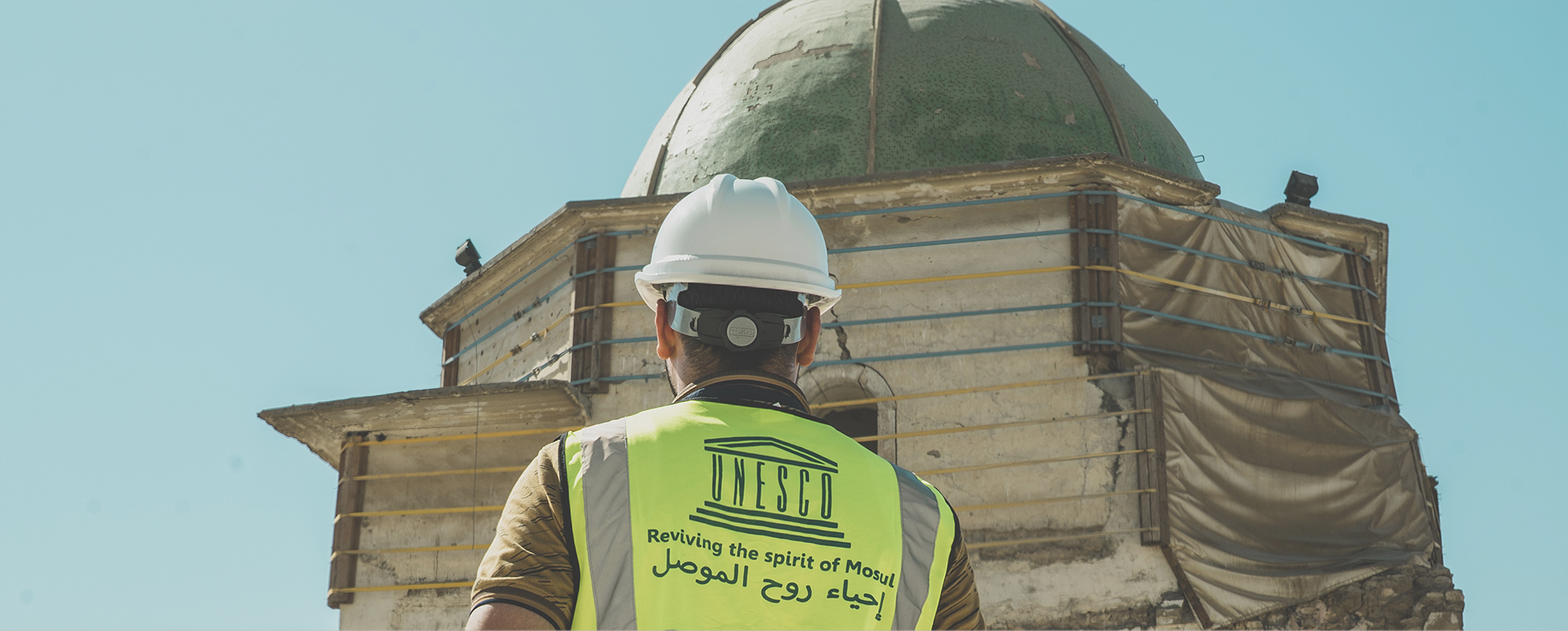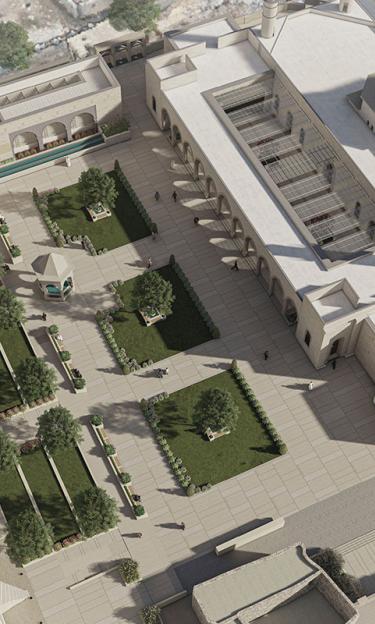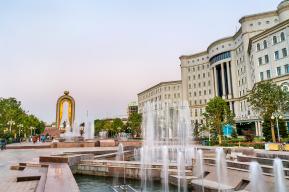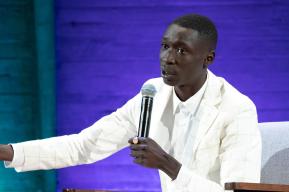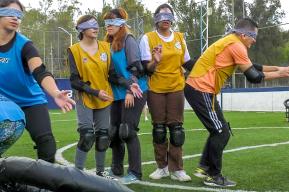Chapter 1: Demining, clearing and stabilizing
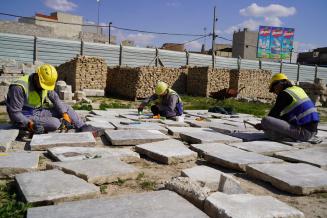
After three years of occupation and several battles, Mosul was liberated, leaving the city in rubble and Mosulis suffering the consequences. Early in the year that followed, UNESCO was set on a path of reconstruction and reconciliation with the objective of bringing this rich and diverse city with its pluralistic history back to its former glory. In February 2018, UNESCO Director-General Audrey Azoulay announced the launch of the Organization's flagship initiative, "Revive the Spirit of Mosul" to restoring Mosul’s history, heritage and life, reviving the very spirit of the city.
In Autumn 2018, in partnership with the United Arab Emirates, work on the preparatory phase of the rehabilitation and reconstruction of Al-Nouri complex and its Minaret started. This included demining the sites, consolidating the remaining structures, and clearing rubble as soon as the site was handed-over to UNESCO in February 2019. Clearing the rubble was in fact more than the removal of broken bricks and stones, it was also about finding valuable pieces that can be reused in the reconstruction process and separating them from the rubble. It was a meticulous task done under the guidance of international experts and archeology students from the University of Mosul.
As for Al-Nouri Mosque, a 2020 survey of residents showed that 70% of the people of Mosul wished to see Al-Nouri Prayer Hall rebuilt as it was before but with some improvements. The public wanted assurances that the essential features and main volumes of the structure would be preserved. UNESCO launched an international Competition for the selection of the design of Al-Nouri Mosque. The winners, an Egyptian team of four partners selected in April 2021, developed the final design with a local partner, the University of Mosul, and many consultations with the Union of Architects/Engineers and local experts. The final visual was approved by the Ministry of Culture and the Sunni Endowment in May 2022.
Chapter 2: Unveiling archeological remains
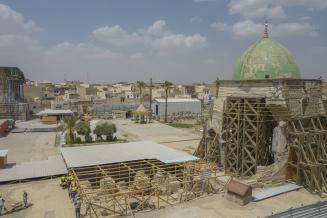
In addition to the preparation process, a group of 40 workers and architects made a wonderful archeological discovery of four rooms under the prayer hall that date back to the 12-century. This remarkable discovery unearthed the original floor of the mosque before its reconstruction in 1940 was uncovered. The State Board of Antiquities and Heritage of Iraq is working with UNESCO to ensure that it is renovated and preserved as a museum where people will be able to learn about the different phases of the mosque’s history. This discovery has been integrated in the detailed design of the prayer hall and its reconstruction will start in the coming months.
I was overwhelmed with happiness when I heard about the discoveries! Having this heritage, preserved for so many years underground, having it escape the intentional destruction of heritage that the rest of the city endured, it’s a miracle. It is true that we lost a lot, but hopefully what is coming is better.
Chapter 3: Bringing a city back to life

Revive the Spirit of Mosul also means bringing the Old City back to life by allowing residents to return to their homes that were destroyed during the war. UNESCO is restoring and rebuilding 124 historic houses, with the generous support of the European Union. Before rebuilding, the neighborhood had to be cleared. So far, 2107 tons of rubble and 21 unexploded ordnances have been removed. Today, the reconstruction of the first 44 heritage houses is nearly complete, allowing the families to come back home.
To achieve this, the project is also generating the creation of many jobs encouraging Mosuli youth to join our apprenticeship programme to encourage the local population to rebuild their city with their own hands.
During the war, the destruction was very frightening. All the rooms of my house collapsed. In 2019, I got a call saying that my house will be rebuild by UNESCO, I couldn’t believe my ears.
Since 2021, Ahmad is once again living in the house where he was born:
My house was rebuilt in one year. It’s a new life that begins. There is nothing better than the smell of my neighborhood.
Today, 67 families, a total of 305 people, benefitted from the first phase of the reconstruction of heritage houses. In the second phase, UNESCO will rebuild 80 houses, creating homes for 110 families, that is over 400 people.
Chapter 4: Rebuilding the soul of Mosul’s skyline
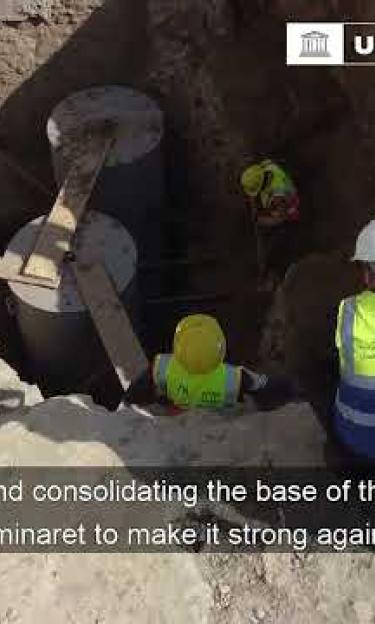
Revive the Spirit of Mosul is a ground-up initiative that aims not only to restore the historic elements of this iconic city but to also reinvigorate the sense of community that among other things includes religious diversity.
At one intersection of history and diversity is the work UNESCO, in partnership with the United Arab Emirates, undertook to restore and rebuild Al-Nouri Mosque Complex and Al-Tahera Syriac Catholic Church and Al-Saa’a Church.
Today, the active reconstruction of the two churches has started as well as the reconstruction of Al-Hadba minaret. Hand in hand with the local population and in partnership with Iraq authorities, UNESCO will rebuild the minaret as it was before its destruction in 2017, it is an architectural challenge that requires innovative solutions.
The minaret was initially built straight, but over the centuries it leaned. This angle, this inclination, was noticeable around the fourteenth century when it earned its name “Al-Habda”, the hunchback. It became an important symbol for the people of Mosul dominating the city’s skyline.
Rising to the challenge with its partners, both local and international, UNESCO put in place a state-of-the-art project based on the most advanced engineering practices that will guarantee the stability of the monument, while ensuring that materials, including over 40 thousand bricks from the original minaret, and reconstruction techniques are compatible.
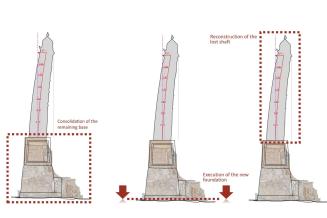
Progress has also been made in the reconstruction process of Al-Nouri Mosque prayer hall. In the past couple of years, the architectural competition for the reconstruction of the prayer hall was completed.
Over the past 5 years, 15 partners have joined UNESCO’s project, making it possible to mobilize over 105,5 million dollars. With this major international mobilization, UNESCO is spearheading several other projects, to provide professional training, create jobs, rebuild schools, fight violent extremism through education, revive cultural life with festivals, books, music, cinema.
The road ahead is still long, but now with hope of a peaceful future ahead. With every brick, every book, every event, and every house, Mosulis are turning the page on war and suffering and looking at the life they would like to build for their city and their families.
